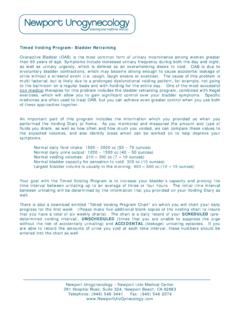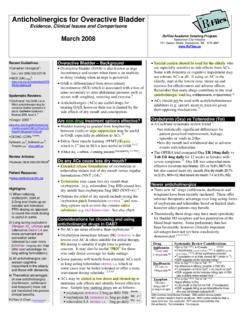Transcription of Kegel Exercise for Men - UCLA
1 Kegel Exercises for Men The following information is based on the general experiences of many prostate cancer patients. Your experience may be different. If you have any questions about what prostate cancer treatment services are covered by your health insurance, please contact your health care provider or health insurance provider. This education material was made possible by a Grant from the California Department of Justice, Antitrust Law Section, from litigation settlement funds to benefit Californians diagnosed with cancer or their families.
2 Table of Contents What Will I Learn By Reading This Booklet?.. 2 What Are pelvic floor Muscles? .. 3 What are Kegel Exercises?.. 4 Why Should I Do Kegel 5 How Do I Find My pelvic floor Muscles? .. 6 How Do I Do A Kegel Exercise ? .. 7 How Often Should I Do My Kegel Exercises? .. 8 When Should I Do The Kegel Exercises?.. 9 Can I do Kegel Exercises If I Have A Catheter? .. 10 Will My Urine Leakage Stop if I Do The Kegel Exercises? .. 11 What Have I Learned By Reading This Booklet?.. 12 Key 13-14 Please feel free to read only those parts of the booklet you need now.
3 You don t need to read everything right now. You can always read more later. 2 What Will I Learn By Reading This Booklet? When you have prostate cancer surgery or radiation therapy the muscles that help you control your urine flow may be weakened. When this happens you may have incontinence. Incontinence is when you leak or pass urine when you do not want to. This is a very common side effect or unwanted change of prostate cancer treatment. The good news is that there is a simple Exercise , called a Kegel (Key-gul) Exercise , you can do to help strengthen your muscles.
4 This Exercise will help you have more control over your urine flow after your prostate cancer treatment. In this booklet you will learn: What a Kegel Exercise is Why you should do Kegel exercises How to find your pelvic floor muscles How often you should do your Kegel exercises It is important for you to think about and plan how you will take care of yourself before and after your prostate cancer treatment so that you can keep doing as many of your normal activities as possible. Words that appear in bold (dark text) can be found in the Key Words section at the end of this booklet.
5 3 What Are pelvic floor Muscles? Your pelvic floor muscles are a network of muscles that support your bladder and help you control your urine flow. There are three pelvic muscles: 1. The bladder . Your bladder is a muscle shaped like a balloon and holds your urine. 2. The sphincter muscles. These muscles help you open and close your urethra, the tube that drains urine from your bladder . And, 3. The pelvic floor muscle [also known as the pubococcygeus (pu-bo-kak-sij-e-us) or PC muscle] supports your bladder and rectum and helps control your urine flow.
6 Sphincter muscle Picture of pelvic floor Muscles 4 What Are Kegel Exercises? Kegel exercises are easy exercises you can do before and after your prostate cancer treatment to help strengthen your pelvic floor muscles. These muscles help control your urine flow. Kegel exercises are one of the most effective ways of controlling incontinence without medication or surgery. 5 Why Should I Do Kegel Exercises? The prostate is a gland, about the size of a walnut, located under the bladder surrounding the upper part of the urethra. The urethra is a tube that carries urine through the penis to the outside of the body.
7 There are many muscles that surround the prostate gland. These muscles may be weakened during your prostate cancer treatment. This may cause you to have urine leakage also known as incontinence. Building up the strength in your pelvic floor muscles can help you gain better control of your bladder and urine flow. Remember, that just as it takes time to build your biceps and strengthen any other muscle in your body, it takes time to strengthen muscles in your pelvic floor . 6 How Do I Find My pelvic Muscles? In order to help strengthen you pelvic floor muscles, it is important that you take time to make sure you are exercising the right muscles.
8 It may take you several tries to find your pelvic muscles. So, take your time. There are several ways that you can find your pelvic floor muscles. One way is to: 1. Try to stop and start your urine stream while you stand at your toilet to urinate (pee). Try to do this two or three times. Another way to find your pelvic floor muscles is to: 1. Imagine that someone walks in to your bathroom while you are urinating (peeing) and you need to stop your urine flow. 2. Try to stop your urine flow. The muscles you use to stop your urine flow are your pelvic floor muscles.
9 These are the muscles you want to strengthen before and after your prostate cancer treatment. 7 How Do I Do A Kegel Exercise ? Now that you have located your pelvic floor muscles, you can Exercise them even when you do not have to urinate (pee) by following these simple steps: 1. Tighten and hold your pelvic floor muscles for five seconds (count 1 one thousand, 2 one thousand, 3 one thousand, 4 one thousand, 5 one thousand). 2. Relax your pelvic muscles. You have just done one Kegel Exercise . You should plan to do 10 to 20 Kegel exercises three to four times each day.
10 Another way to tighten your pelvic floor muscles is to: 1. Squeeze the muscles in your anus (like you are holding a bowel movement). 2. Relax your pelvic floor muscles after each attempt. 3. Repeat this Exercise 10 to 20 times. When you do your Kegel exercises, remember Do not hold your breath. Do not push down. Squeeze your muscles together tightly and imagine that you are trying to lift this muscle up. Do not tighten the muscles in your stomach, buttocks, or thighs. Relax your pelvic floor muscles between each squeeze. 8 How Often Should I Do Kegel Exercises?









